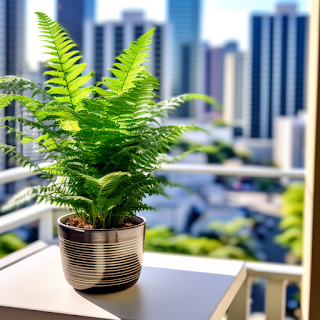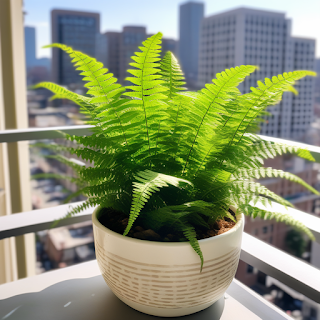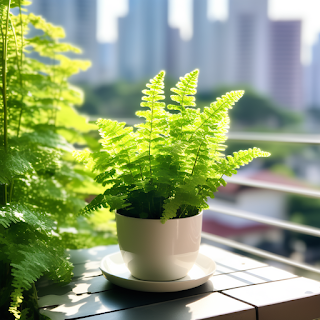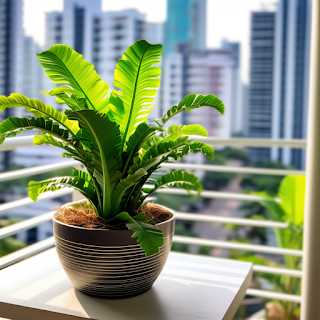Air pollution, a modern challenge, poses significant threats to human health. With the rise of urbanization and industrialization, pollutants such as particulate matter, nitrogen dioxide, and volatile organic compounds infiltrate the air we breathe.
The consequences are dire, contributing to respiratory issues, cardiovascular diseases, and a host of other health complications. As urban dwellers seek ways to combat this invisible enemy, the role of plants in purifying the air becomes a crucial aspect of creating healthier living spaces
| Key Takeaway | Details |
|---|---|
| Ferns are effective air purifiers, removing harmful toxins from the air. | Ferns can remove common household toxins such as formaldehyde, benzene, and ammonia from the air. |
| Ferns are well-suited for balconies, as they thrive in indirect sunlight and humid conditions. | Ferns are shade-loving plants that prefer moist environments, making them ideal for balconies. |
| Several fern species are excellent choices for balcony air purification, including Boston Fern, Maidenhair Fern, Staghorn Fern, Bird's Nest Fern, and Kimberly Queen Fern. | Each of these fern species has unique characteristics and care requirements, so it is important to choose one that is suitable for your balcony's conditions. |
| Proper care for balcony ferns includes providing adequate sunlight, watering regularly, maintaining humidity levels, and fertilizing periodically. | By following these care guidelines, you can ensure that your balcony ferns flourish and continue to purify the air. |
| Ferns add a touch of elegance and greenery to balconies, making them not only functional but also aesthetically pleasing. | With their lush foliage and air-purifying abilities, ferns can transform balconies into tranquil and refreshing spaces. |
Diversity in Ferns
The world of ferns is vast, with various species offering unique textures, shapes, and sizes. From the lacy fronds of the Boston Fern to the compact elegance of the Japanese Painted Fern, there's a fern for every balcony garden style.
Low Maintenance Charm
One of the key attractions of ferns is their low maintenance. Generally, ferns are resilient and can thrive with minimal care. This makes them an excellent choice for balcony gardeners who want to enjoy greenery without constant upkeep.
Benefits of Ferns as Air Purifiers
Apart from their aesthetic appeal, ferns contribute significantly to creating a healthier living space through their air-purifying qualities.
Natural Air Purifiers
Ferns are known for their ability to purify the air by removing toxins. They act as nature's air filters, enhancing the quality of the air you breathe in your balcony. This is particularly beneficial for urban dwellers facing pollution concerns.
Improved Indoor Air Quality
Studies have shown that certain fern species, such as the Boston Fern and the Kimberly Queen Fern, are effective in removing pollutants like formaldehyde and benzene from the air. This not only enhances the ambiance of your balcony but also promotes better respiratory health.
Suitability of Ferns for Balcony
When it comes to balcony gardening, not all plants are created equal. Ferns, however, offer unique advantages that make them particularly suitable for balconies.
Adaptability to Balcony Conditions
Ferns are well-suited for the conditions commonly found on balconies. Many fern varieties thrive in the shade, making them perfect for balconies with limited sunlight exposure. This adaptability ensures that even if your balcony doesn't receive direct sunlight, you can still enjoy the lush greenery of ferns.
Container Gardening Delight
Ferns are container-friendly, allowing you to unleash your creativity in balcony design. Their ability to thrive in pots and hanging baskets means you can strategically place them to maximize space and create a visually appealing balcony garden.
Suitable Ferns for Balcony Air Purification
Ferns not only bring a touch of natural elegance to your balcony but also serve as efficient air purifiers. Here's a closer look at some suitable ferns for balcony gardening, each with its unique characteristics, air purification capabilities, and care requirements.
Boston Fern
Characteristics
- Foliage: Lacy, feathery fronds.
- Size: Medium-sized, cascading growth.
- Appearance: Elegant and vibrant green.
Air Purification Capabilities
Boston Ferns are excellent natural air purifiers, known for their ability to remove pollutants like formaldehyde and xylene from the air.
Care Requirements
- Light: Indirect sunlight or partial shade.
- Water: Keep soil consistently moist.
- Humidity: Thrives in high humidity.
Maidenhair Fern
Characteristics
- Foliage: Delicate, fan-shaped fronds.
- Size: Compact and dainty.
- Appearance: Graceful and airy.
Air Purification Capabilities
Maidenhair Ferns contribute to air purification by filtering out pollutants like benzene and ammonia.
Care Requirements
- Light: Indirect light, avoid direct sunlight.
- Water: Keep soil consistently moist but not waterlogged.
- Humidity: Requires high humidity.
Staghorn Fern
Characteristics
- Foliage: Unique antler-like fronds.
- Size: Varied, depending on mounting.
- Appearance: Distinct and artistic.
Air Purification Capabilities
Staghorn Ferns act as effective air purifiers, removing toxins and adding a touch of green art to your balcony.
Care Requirements
- Light: Indirect light, avoid direct sunlight.
- Water: Soak or mist regularly, allow drying between waterings.
- Mounting: Often mounted on boards or baskets.
Bird's Nest Fern
Characteristics
- Foliage: Crisp, nest-like rosettes.
- Size: Medium to large.
- Appearance: Bold and tropical.
Air Purification Capabilities
Bird's Nest Ferns excel at removing pollutants like formaldehyde, making them valuable contributors to air quality.
Care Requirements
- Light: Indirect light to partial shade.
- Water: Keep the soil consistently moist but not waterlogged.
- Humidity: Enjoys higher humidity levels.
Kimberly Queen Fern
 |
Kimberly Queen Fern |
Characteristics
- Foliage: Arching, finely cut fronds.
- Size: Large and upright.
- Appearance: Majestic and lush.
Air Purification Capabilities
Kimberly Queen Ferns are effective in filtering pollutants, particularly formaldehyde, making them an asset to your balcony air quality.
Care Requirements
- Light: Indirect light or filtered sunlight.
- Water: Allow the soil to dry slightly between waterings.
- Maintenance: Prune dead fronds for aesthetic appeal.
Tips for Caring for Ferns on Balconies
Ferns, with their lush green fronds, are a delightful addition to balcony gardens. To ensure these botanical beauties thrive, consider these essential care tips tailored for balcony conditions.
Sunlight Requirements
Balconies often have varying levels of sunlight exposure, and selecting the right spot for your fern is crucial.
Shade-Loving Ferns: Many fern varieties, including Boston Ferns and Maidenhair Ferns, prefer indirect light or partial shade. Avoid placing them in direct sunlight, which can scorch their delicate fronds.
Filtered Light: If your balcony receives intense sunlight, create shade with sheer curtains or place ferns in spots with filtered light to protect them from harsh rays.
Watering Needs
Proper watering is key to fern health, and balcony conditions may affect their hydration levels.
Consistent Moisture: Ferns generally thrive in consistently moist soil. Ensure the soil doesn't dry out completely, but also avoid waterlogged conditions.
Humidity Trays: Balconies can be dry environments, especially in arid climates. Placing humidity trays filled with water near your ferns can help maintain the moisture they crave.
Humidity Requirements
Ferns, hailing from lush, humid environments, appreciate higher humidity levels.
Misting: Periodically misting your ferns can mimic their natural habitat, providing the humidity they need. This is especially beneficial during dry spells or in air-conditioned spaces.
Grouping: Positioning ferns together can create a microclimate with increased humidity. Grouping them also enhances the visual appeal of your balcony oasis.
Temperature Tolerance
Ferns generally thrive in mild temperatures, and understanding their tolerance levels is vital.
Avoid Extreme Cold or Heat: While ferns prefer temperatures between 60-75°F (15-24°C), they can withstand slightly cooler or warmer conditions. However, extreme temperatures should be avoided to prevent stress on the plants.
Winter Protection: In colder climates, consider bringing your ferns indoors during winter or providing them with adequate protection, such as covering them with blankets or burlap, to shield them from frost.
Fertilization
Balcony ferns benefit from occasional fertilization to support their growth and vitality.
Balanced Fertilizer: Use a balanced liquid fertilizer formulated for houseplants or ferns. Apply it during the growing season, typically spring and summer, following package instructions.
Dilution Matters: Avoid over-fertilizing, as ferns are generally moderate feeders. Dilute the fertilizer to half or quarter strength to prevent nutrient buildup in the soil.
Conclusion
Ferns as Balcony Air Purifiers: A Summary
In the quest for a green and healthy balcony haven, ferns emerge as versatile allies. Beyond their aesthetic charm, ferns contribute significantly to improving air quality in your outdoor space. Let's recap the key points that make ferns a compelling choice for balcony air purification:
Natural Filtration: Ferns, such as the Boston Fern and Kimberly Queen Fern, act as natural air purifiers, filtering out pollutants like formaldehyde and benzene.
Diverse Options: The variety of fern species allows you to choose plants that not only suit your balcony's conditions but also align with your visual preferences. From the delicate Maidenhair Fern to the bold Bird's Nest Fern, there's a fern for every balcony style.
Low Maintenance Purity: Ferns require minimal maintenance, making them ideal for balcony gardeners seeking both greenery and air-purifying benefits without the hassle of constant care.
Enriching Your Balcony with Ferns
As you embark on the journey of cultivating a fern-filled balcony oasis, consider the following insights to maximize the enrichment ferns bring to your outdoor space:
Strategic Placement: Choose the right spot on your balcony based on the sunlight conditions preferred by your selected fern species. Creating microclimates through groupings and filtered light enhances their well-being.
Proper Watering Rituals: Master the art of consistent moisture without overwatering. Balcony ferns thrive when the soil stays moist, providing the optimal environment for their growth.
Humidity Boosts: Mimic the ferns' native humid habitats by incorporating misting routines and humidity trays. These simple additions can make a significant difference in the overall health of your ferns.
Temperature Harmony: Be mindful of temperature extremes, protecting your ferns from harsh weather conditions. Consider moving them indoors during chilly winters or providing adequate shielding against scorching heat.
Fertilization Wisdom: Enhance your ferns' vitality with balanced fertilization during the growing season. Dilute fertilizers appropriately to prevent nutrient buildup and promote healthy growth.
The inclusion of ferns in your balcony garden is not just an aesthetic choice; it's a commitment to creating a harmonious and healthier living space. From their air-purifying abilities to their adaptability to balcony conditions, ferns stand as resilient companions in your journey toward a flourishing balcony garden. Embrace the green revolution on your balcony, and let ferns transform it into a vibrant and purified retreat.





